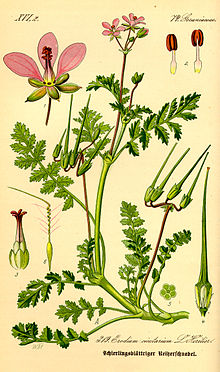Common heron beak
| Common heron beak | ||||||||||||
|---|---|---|---|---|---|---|---|---|---|---|---|---|

Common heron beak ( Erodium cicutarium ) |
||||||||||||
| Systematics | ||||||||||||
|
||||||||||||
| Scientific name | ||||||||||||
| Erodium cicutarium | ||||||||||||
| ( L. ) L'Hér. ex Aiton |
The Ordinary Filaree ( Erodium cicutarium ), often Schierlingsblättriger Filaree , belongs to the genus erodium within the family of geraniaceae (Geraniaceae). Often the clans dune heron beak ( Erodium ballii Jord. ) And Danish heron beak ( Erodium danicum Lars. ) Are separated, whose taxonomic rank is uncertain. They differ in the number of flowers per inflorescence as well as in the length of the fruit beaks and the partial fruits.
features

The common heron beak is a one to two year , rarely perennial herbaceous plant . The plant initially grows in a flat leaf rosette, later lying down to almost upright and reaching heights of between 10 and 40, sometimes 60 centimeters. The stems are hairy and hardly glandular. The leaves are pinnate to the median nerve. The feathers themselves are divided again and have narrow, pointed tips.
The flowers stand in pairs to ten in long-stalked, dold-like inflorescences . The pedicels and sepals are hairy glandular and / or glandeless. The petals are between 5 and 9 millimeters long. They are pink or purple, rarely white. The two upper ones are often smaller and sometimes have a light or dark spot. The flowers each have five stamens and a star-shaped stigma. The 25 to 40 mm long fruit beaks are bent back like a heron neck during the ripening period (hence the name). The plant blooms between April and September with a main flowering time in May.
The number of chromosomes is 2n = 40.
ecology
The flowers are homogamous "small funnel flowers "; seldom they are also somewhat bilaterally symmetrical and pre-masculine. Mostly self-pollination takes place .
The fruits are long-billed clefts due to the greatly elongated style. The five 5 to 7 mm long partial fruits split off from the fruit column when they dry out with the seeds . The withdrawal of water from the swelling tissue causes a helical curvature of the lower section. When it comes into contact with water, the source tissue expands and the partial fruit bores itself into the ground or into an animal's skin, or it moves as a crawler. Fruit ripening is from August to October.
Distribution and location
The common heron beak is widespread worldwide and also in all of Germany . It grows on paths, in fallow land , in vineyards and inland dunes . In Austria it is very common to often in all federal states. It grows on warm, moderately dry to dry, moderately nutrient-rich and base-rich, often lime-poor, less humus-rich , loose loam, stone and sandy soils. He is a sand pointer and a pioneer plant . He prefers uneven weed meadows as well as dry and semi-dry grasslands . In Central Europe it is a weak character species of the Sedo-Scleranthetea class, but also occurs in societies of the Secalietea class or the order Polygono-Chenopodietalia.
Common names
Exist or were the other German-speaking for the ordinary Filaree trivial name : Aadbarschnibb ( Pomerania ), wild Schnabel ( Silesia ), Chranchesnabel ( Old High German ), Chranichessnabel (Old High German), Cranchesnabel, Cranchsnabel, shepherds nobility, Kaczsnabel ( Middle High German ), Kranchsnabel, Krankensnawel ( Middle Low German ) Kranessnawel (middle Low German), Krangeschnabl (middle Low German), Kranichesnagel (medium high German), Kranichissnavel, crane nail (medium high German), Kranichsnabil (althochdeutsch), crane navel (medium high German), Kranssesnabel (medium high German), Schirlingskraut, Snissblom ( Altmark ) Spinblaum ( Wangerooge ) , Storchenschnabel ( Bern ) and Storkenschnabel.
literature
- Henning Haeupler, Thomas Muer: picture atlas of the fern and flowering plants of Germany . Ed .: Federal Agency for Nature Conservation (= The fern and flowering plants of Germany . Volume 2 ). Eugen Ulmer, Stuttgart (Hohenheim) 2000, ISBN 3-8001-3364-4 .
- Erich Oberdorfer : Plant-sociological excursion flora . With the collaboration of Theo Müller. 7th, revised and expanded edition. Eugen Ulmer, Stuttgart (Hohenheim) 1994, ISBN 3-8252-1828-7 .
Individual evidence
- ^ Erich Oberdorfer : Plant-sociological excursion flora for Germany and neighboring areas . 8th edition. Verlag Eugen Ulmer, Stuttgart 2001, ISBN 3-8001-3131-5 . Page 629.
- ↑ a b Ruprecht Düll , Herfried Kutzelnigg : Pocket dictionary of the plants of Germany and neighboring countries. The most common Central European species in portrait . 7th, corrected and enlarged edition. Quelle & Meyer, Wiebelsheim 2011, ISBN 978-3-494-01424-1 .
- ^ Georg August Pritzel , Carl Jessen : The German folk names of plants. New contribution to the German linguistic treasure. Philipp Cohen, Hannover 1882, page 144. ( online ).
Web links
- Common heron beak. In: FloraWeb.de.
- Profile and distribution map for Bavaria . In: Botanical Information Hub of Bavaria .
- Erodium cicutarium (L.) L'Hér. In: Info Flora , the national data and information center for Swiss flora .
- Distribution in the northern hemisphere from: Eric Hultén, Magnus Fries: Atlas of North European vascular plants. 1986, ISBN 3-87429-263-0 at Den virtuella floran (swed.)
- Thomas Meyer: Data sheet with identification key and photos at Flora-de: Flora von Deutschland (old name of the website: Flowers in Swabia )
- Erodium cicutarium in botany in the picture / Flora Austria

